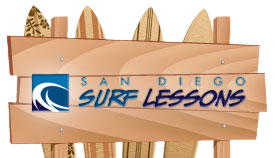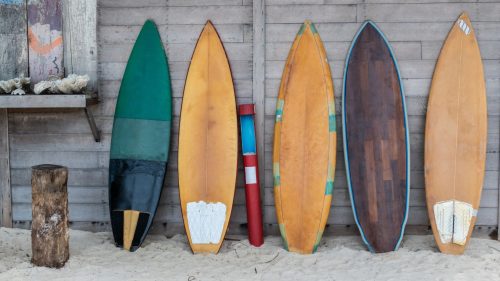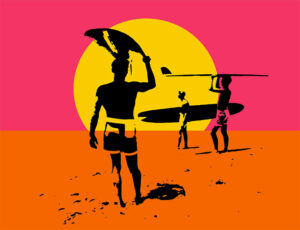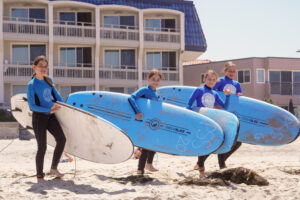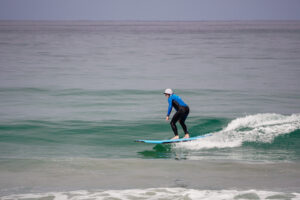Surfing boasts a rich history that spans centuries, with its roots deeply planted in ancient Polynesian culture. It is widely believed that the Hawaiian Islands served as the birthplace of surfing, eventually spreading its reach to other regions across the globe. The surfboards of today, though derived from these early origins, have undergone vast transformations and improvements in the pursuit of innovation and performance. In this article, we will embark on a fascinating journey through the history of surfboard design, tracing its evolution from primitive wooden planks to the highly sophisticated equipment of the present day. Furthermore, we will shed light on the possible future trends that could continue to shape the surfboard industry. Remember, if you wish to immerse yourself in the exhilarating world of surfing, there’s no better place to start than with San Diego Surf Lessons (SSL).
Ancient Polynesians revered surfing as more than just a recreational activity; it held considerable cultural significance. They considered the art of riding waves on wooden planks a sacred practice, a means of communing with the ocean and connecting with the divine. These early surfers crafted their surfboards from the wood of three indigenous trees – koa, wiliwili, and ‘ulu. The boards varied in shape, size, and weight, depending on the craftsman’s interpretation of the surfer’s social standing and the types of waves they would ride.
The Hawaiians had a deeply ingrained respect for the ocean and its life-sustaining power, which was reflected in their meticulous construction of surfboards. Surfboard shapers were esteemed members of society, and they lavished great care and attention on their craft. They performed rituals and prayers to ensure the process aligned with their spiritual beliefs. This spiritual connection to surfing and the ocean is still evident today and remains an integral part of the surfing ethos.
Over time, the influence of Western explorers on Polynesian cultures led to the gradual decline of traditional surfing practices. However, as the 20th century dawned, a renaissance took root, and surfing made a triumphant resurgence. This marked the beginning of a new era in surfboard design, fueled by technological advancements and inspired visionary shapers, eager to push the boundary of what was possible on the waves. This new wave of innovation set the stage for the emergence of modern surfboards that have come to define the surfing experience.
So, dive into the captivating world of surfing and its dynamic evolution by continuing to read through this article. And don’t forget, if you’re ready to embark on your own surfing adventure, San Diego Surf Lessons (SSL) awaits to help you experience the thrill of riding the waves.
Ancient Surfboards: The Olo and Alaia
The first surfboards were made from wood, and they were giant planks designed to enable the rider to catch waves. The ancient Hawaiians developed two main types of surfboards: the Olo and Alaia. The Olo was a long, narrow board reserved for chiefs and other high-ranking individuals. On the other hand, the Alaia was a shorter, wider board used by commoners.
These boards allowed surfers to ride massive waves, but they were difficult to control due to their size and weight. Despite their limitations, these early forms of surfboards laid the foundation for modern surfboard designs.
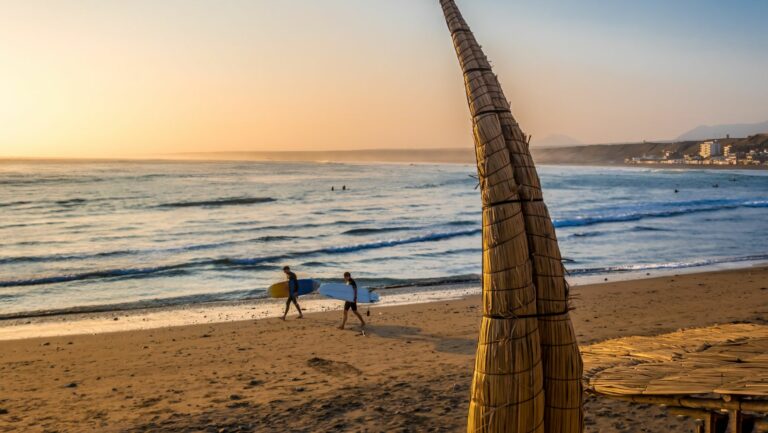
The 20th Century: Innovation and Material Advancements
The arrival of the 20th century saw a significant shift in surfboard design, as materials and construction techniques advanced. The first major breakthrough was the introduction of lightweight materials like foam and fiberglass in the 1950s. This new combination made surfboards lighter and more buoyant, allowing surfers to perform better on the waves.
Shortboards, longboards, and fish boards were among the most popular designs in this era. The shortboard was designed for speed and maneuverability, while the longboard was perfect for bigger waves. The fish board offered a compromise between the two, providing the maneuverability of a shortboard with the stability and paddle power of a longboard.
Modern Surfboard Design: High-Performance and Customization
Today’s surfboards are designed for optimal performance, speed, and control. The best surfers in the world can now carve, turn, and perform aerial maneuvers that were once impossible on the earlier surfboard designs.
One of the most popular modern surfboards is the thruster or tri-fin surfboard. The thruster features three fins, allowing for better control, stability, and maneuverability. This design has become the go-to board for surfers in competitions due to its performance capabilities.
Customization has also become a crucial aspect of modern surfboard design. Surfers can now choose from an array of materials, shapes, and sizes to suit their style and preferences. Some even opt for eco-friendly surfboards made from sustainable materials like bamboo, recycled foam, and bio-resins.
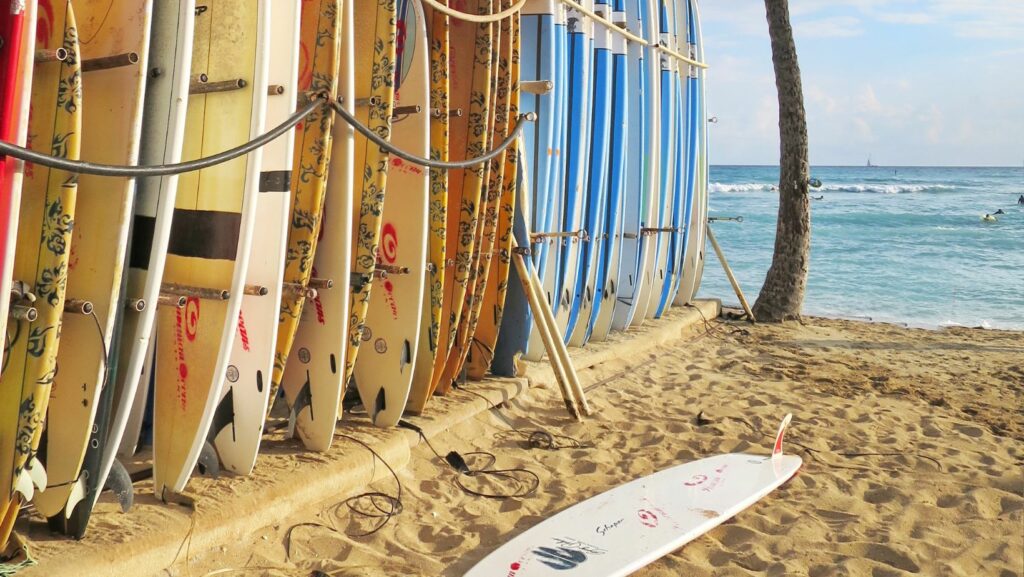
Future Trends in Surfboard Design
As we look into the future, some emerging trends could change the landscape of surfboard design. Here are a few of them:
- Advanced Materials: Research and development in materials science could lead to stronger, lighter, and more eco-friendly surfboards. Carbon fiber and graphene are examples of materials that could revolutionize surfboard manufacturing.
- 3D Printing: As 3D printing technology becomes more advanced, it could open doors for custom-made surfboards tailored specifically to a surfer’s style and preferences. This would allow for even greater personalization and optimization.
- Smart Surfboards: The incorporation of smart technology in surfboards may become common in the future. Some companies are already developing boards equipped with sensors and GPS tracking devices, which can provide invaluable data to surfers looking to improve their performance.
Ride the Waves with SSL: Surf Lessons in San Diego
Surfboard design has come a long way since the days of the ancient wooden Olo and Alaia. Today’s surfboards offer exceptional performance, allowing surfers to push the limits of what can be achieved on the waves. However, surfing is not just about having the right equipment—it’s also about knowing how to use it.
If you’re looking to improve your surfing skills, join us at San Diego Surf Lessons (SSL) for expert instruction and guidance. Our experienced instructors will teach you the techniques you need to navigate the waves with confidence, no matter your skill level. Start your surfing journey with us and ride the waves like never before!
FAQ
San Diego Surf Lesson is the leading surf school around the world with our headquarters based in San Diego. We teach surfing lessons in many different surf locations and our top priority is providing the best surfing experience.
We have instructors from all over the world that are surf experts. They are all trained with Water Safety Courses, with over a thousand 5 stars reviews and coached to teach to all ages, specialized in beginners and intermediate students.
You can book the surf lessons in our store in Pacific Beach and over the phone, but if you already figured out what surfing lesson you want and when you want to go surfing the easiest way is booking it online through our website.
All of our surf lessons are one and a half hours. The surfboard, wetsuit, leash and rash guard are already included.
The lesson starts with land lesson in which the surfing instructor explains about the dangers of the ocean, board information as dynamics and dimensions, what to do and not to do and the position you stand up when catching a wave. After that you enter the water with your surfing instructor to try the real thing, he will help place the board in the correct position and give you pointers.
A private lesson is a one-on-one lesson, which means a instructor just for you and more wave time. If your goal is really learning to surf and making it a habit, this is the best option.
When you arrive for your surf lesson we will provide you with a wetsuit, so you just need whatever you would wear when going to the beach. Board shorts or swimsuits for men, and bikinis or swimsuits for women.
To have a surf lesson with us, you don’t need to worry about bringing any equipment. Our surf school provides everything you need, including Surfboard, Wetsuit, UV Protection, Rash Guard and Leash. You just need to bring Sun Block, Towel, Water, positive attitude, willingness to learn, and maybe some sunscreen.
No previous surfing experience is required to take our lessons. We welcome all skill levels, from complete beginners to more experienced surfers who want to improve their technique. Our instructors are trained to tailor the lesson to your individual needs, whether you are looking to learn the basics or refine your skills. So, if you have never surfed before, don’t worry – we’ll help you catch your first wave and have a great time!
If you need to cancel your surf lesson, please follow the guidelines below to ensure a smooth cancellation process:
Lesson Arrival:
– Check in at least 15-20 minutes before the lesson starts.
– Arriving 10 minutes after the lesson start time will be considered a no-show.
– Late arrivals will not be refunded but may reschedule the reservation for 50% of the price of a future reservation.
– One ID is required per reservation at check-in.
Cancellations and Rescheduling:
– Reservations must be canceled by email at least 48 hours before your lesson to receive a refund, credit, or reschedule the lesson.
– There are no refunds or credits for no-shows and/or cancellations requested less than 48 hours before the scheduled lesson.
– Changing or rescheduling your reservation within 72 hours is subject to a rescheduling fee of $25, and no refunds will be provided for the initial booking.
– No refunds will be given on surf lesson packages after the lessons have started.
Refund Policy:
– There are no refunds once you arrive at the beach unless lifeguards or instructors shut down the lesson for safety reasons.
– We want to get you on the water, and credit can be applied in certain circumstances.
– There is no expiration on the credit, and it is transferable to friends and family.
Please note that traffic throughout Southern California can be unpredictable, so plan accordingly, especially if driving from the LA area. We do not grant refunds or reschedule lessons for any late arrivals. Participants under 18 must have a legal guardian present to sign a liability form, or use an online waiver if a guardian will not be in attendance.
Parking can be challenging, especially on weekends, so allow at least 30 minutes to find a spot. On the day of your lesson, bring a comfortable bathing suit, towel, sunscreen, and a water bottle. Wetsuits and surfboards will be provided by the surf school.
Our surf lessons typically last 90 minutes, which we believe is the perfect amount of time to learn and practice new skills while also having a great time in the water. During this time, you’ll receive personalized instruction from one of our experienced surf coaches, who will help you improve your technique and get the most out of your lesson. We find that 90 minutes is the ideal duration for both beginners and more experienced surfers, allowing for a full and rewarding surfing experience without getting too fatigued.
Yes, it is generally safe to surf in San Diego, as long as you follow basic safety guidelines and take necessary precautions. San Diego has a reputation as one of the best surf destinations in the world, with consistent waves and a vibrant surfing culture. However, like any ocean activity, surfing can also have some risks, such as rip currents, wave impact injuries, and collisions with other surfers. It’s important to always pay attention to the ocean conditions, check the surf report before heading out, and obey any posted warnings or closures. Additionally, wearing a proper wetsuit and other safety gear, such as a leash, can also help minimize the risks. At our surf school, we prioritize safety and always provide our students with a thorough safety briefing before each lesson.
Yes, our surf lessons are suitable for all skill levels, from complete beginners to more experienced surfers. Our instructors are trained to tailor each lesson to the individual needs and skill level of the student, so you can be sure you’re getting the best instruction possible. If you’ve never surfed before, we’ll start with the basics and help you build a solid foundation of skills and techniques. If you’re a more experienced surfer looking to improve your skills, we’ll work with you to refine your technique and help you reach your surfing goals. No matter what your skill level, our lessons are designed to be fun, safe, and informative, giving you the tools you need to become a better surfer.
Our surf instructors are highly experienced and qualified, holding certifications such as Professional Certified Surf Instructor, as well as CPR and Lifeguard certifications. They have extensive experience teaching students of all skill levels and are trained in the latest techniques and best practices for surfing. In addition to their technical knowledge, our instructors are also skilled communicators and are committed to creating a positive, supportive learning environment for all students. Whether you’re a complete beginner or an experienced surfer, you can trust our certified instructors to provide top-notch instruction and help you achieve your surfing goals, all while ensuring your safety in the water.
Yes, surf lessons are available for children at our surf school, with a minimum age requirement of 5 years old. We welcome young surfers and believe that learning to surf can be a fun and rewarding experience for kids. Our experienced instructors are skilled at teaching children and ensuring that they have a safe and enjoyable time in the water. It is important for children participating in surf lessons to know how to swim. Being able to swim confidently is a crucial safety aspect of surfing, as it ensures that the child can navigate the water effectively and handle any situations that may arise while in the ocean. Before enrolling a child in surf lessons, we recommend that they have basic swimming skills and are comfortable in the water. Our instructors focus on teaching the fundamentals of surfing while emphasizing water safety and building confidence. We tailor our lessons to meet each child’s needs and abilities, providing a supportive and encouraging environment for them to learn and grow as surfers.
Yes, equipment rental is included in the cost of our surf lessons. We provide all necessary equipment, including surfboards, wetsuits, and other safety gear, to ensure that our students have a safe and enjoyable surfing experience. Our equipment is regularly maintained and updated to ensure that it’s in top condition and suitable for a variety of skill levels. So, whether you’re a complete beginner or an experienced surfer, you can be sure that you’ll have access to the best equipment available. By including equipment rental in the cost of our surf lessons, we aim to make surfing accessible and affordable for everyone.
